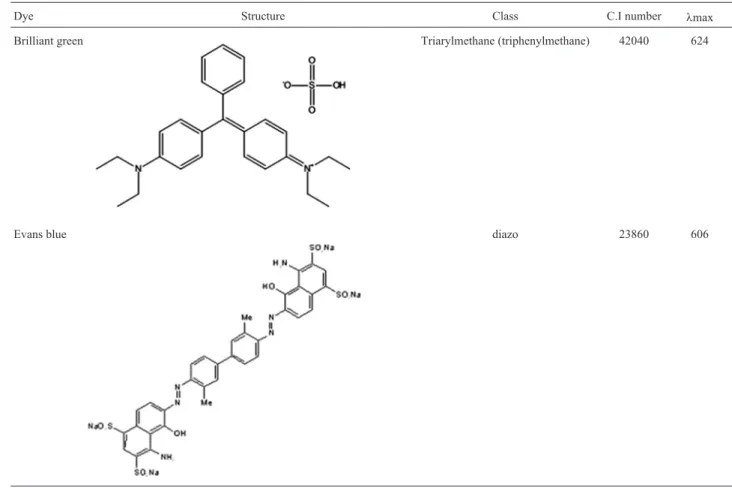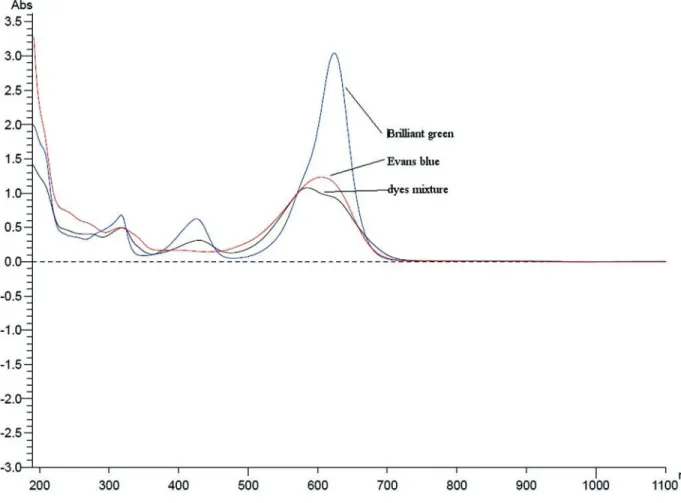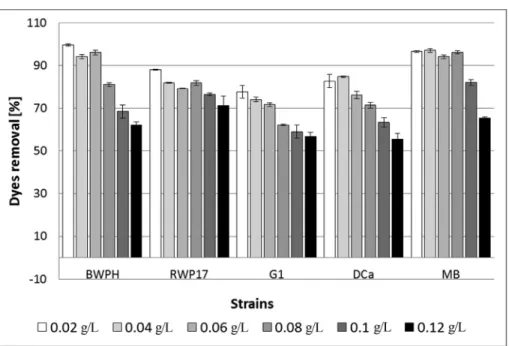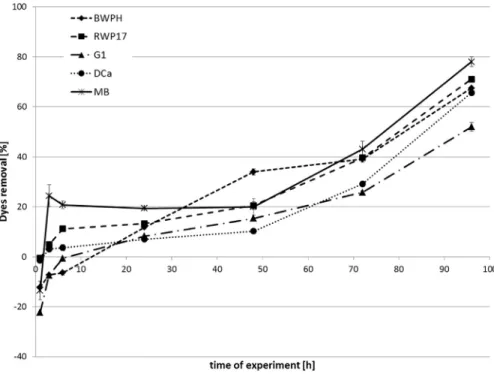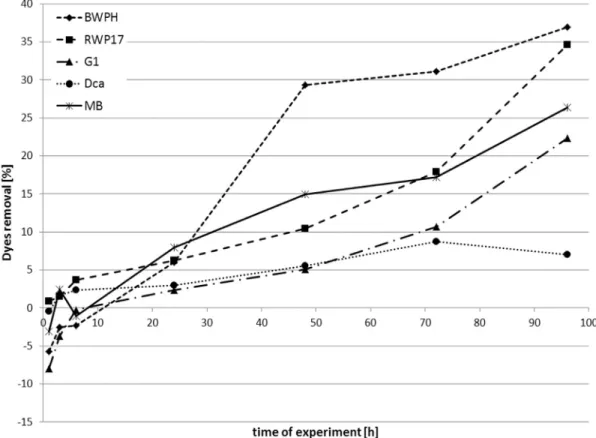Efficacy of fungal decolorization of a mixture of dyes belonging to different classes
Wioletta Przystas, Ewa Zablocka-Godlewska, Elzbieta Grabinska-Sota
Environmental Biotechnology Department, Silesian University of Technology, Gliwice, Poland.
Submitted: February 21, 2014; Approved: October 9, 2014.
Abstract
Dyes are the most difficult constituents to remove by conventional biological wastewater treatment. Colored wastewater is mainly eliminated by physical and chemical procedures, which are very ex-pensive and have drawbacks. Therefore, the advantage of using biological processes, such as the biotransformation of dyes, is that they may lead to complete mineralization or formation of less toxic products. To prove the possibility of using fungal processes for decolorization and other applications, the analysis of the toxicity of the processes’ products is required. The decolorization of the mixture of two dyes from different classes - triphenylmethane brilliant green and azo Evans blue (GB - total con-centration 0.08 g/L, proportion 1:1 w/w) - byPleurotus ostreatus(BWPH and MB),Gloeophyllum odoratum(DCa), RWP17 (Polyporus picipes) andFusarium oxysporum(G1) was studied. Zooto-xicity (Daphnia magna) and phytotoxicity (Lemna minor) changes were estimated at the end of the experiment. The mixture of dyes was significantly removed by all the strains that were tested with 96 h of experimental time. However, differences among strains from the same species (P. ostreatus) were noted. Shaking improved the efficacy and rate of the dye removal. In static samples, the removal of the mixture reached more than 51.9% and in shaken samples, more than 79.2%. Tests using the dead biomass of the fungi only adsorbed up to 37% of the dye mixture (strain BWPH), which sug-gests that the process with the living biomass involves the biotransformation of the dyes. The best re-sults were reached for the MB strain, which removed 90% of the tested mixture under shaking conditions. Regardless of the efficacy of the dye removal, toxicity decreased from class V to class III in tests withD. magna. Tests withL. minorcontrol samples were classified as class IV, and samples with certain strains were non-toxic. The highest phytotoxicity decrease was noted in shaken samples where the elimination of dye mixture was the best.
Key words:decolorization, fungal dye removal, dye mixture, zootoxicity, phytotoxicity.
Introduction
Synthetic azo, triphenylmethane and anthraquinone dyes are used in textile, food, cosmetics, papermaking and pharmaceutical industries (Swamy and Ramsay, 1999; Padamavathyet al., 2003). Their complex aromatic struc-ture allows for their resistance to light and water oxidation and biodegradation. It is a feature desired by the industry using the dye, but it is dangerous for the environment. The non-biodegradable nature of most of the dyes causes their accumulation in surface water and sediments, especially at places of wastewater discharge. It reduces aquatic diversity by blocking the passage of sunlight through the water and creates problems for photosynthetic aquatic plants and
al-gae, thus, affecting the ecological balance in the aquatic system. Many synthetic dyes are toxic, mutagenic and car-cinogenic (Namasivayam and Sumithra, 2005; Divaniyam et al., 2010). Textile finishing wastewater and house effluents may contain different classes of organic dyes, chemicals and auxiliaries (Lin and Chen, 1997; Dos Santos et al., 2007). They are characterized by a strong color and large amount of suspended solids (Golobet al., 2005). The presence of these dyes in wastewater effluents is highly vis-ible even in small concentrations. Dyes are the most diffi-cult constituents to treat by conventional biological wastewater treatment (Gill et al., 2001; Robinson et al., 2001; Yesiladaet al., 2003; Dos Santoset al., 2007; Khan DOI: http://dx.doi.org/10.1590/S1517-838246246220140167
Send correspondence to W. Przystas. Environmental Biotechnology Department, Silesian University of Technology, Akademicka 2A, 44-100 Gliwice, Poland. E-mail: wioletta.przystas@polsl.pl.
et al., 2013). Effective dye removal is required due to strin-gent government legislation and strict environmental regu-lations (Pandeyet al., 2007).
Colored wastewater from the textile industry is one of the most serious problems in the world. In some regions, the textile industry is a significant contributor to the eco-nomic growth of a country. During normal textile dyeing and finishing, the dye used during operations may be changed from day to day and sometimes even several times a day. Approximately 10,000 different dyes are commer-cially available. Imperfections in textile dyeing processes cause a 10-15% loss of the applied dyes (Gillet al., 2001; Robinsonet al., 2001; Yesiladaet al., 2003; Divaniyamet al., 2010). Colored wastewater is mainly eliminated by physical and chemical processes, such as coagulation, floc-culation, adsorption, flotation, precipitation, oxidation and reduction, ozonation and membrane separation. However, they are very expensive and have drawbacks (Azmiet al., 1998; Robinsonet al., 2001). The most widely used treat-ment system, conventional activated sludge, poorly re-moves the most widely used dyes and is clearly ineffective at decolorizing textile effluent, even when mixed and treated together with sewage (Robinsonet al., 2001; Al-Kdasi et al., 2004). Environmentally friendly and cost-competitive bioremediation by microorganisms should be improved. Treatment of textile effluent requires a sound and efficient system able to achieve adequate color re-moval. There are many publications confirming the high potential of bacterial, fungal and algal species in dye re-moval (Banatet al., 1996; Azmiet al., 1998; Pointing and Vrijmoed, 2000; Fu and Viraraghavan, 2001; Robinsonet al., 2001; Sharmaet al., 2004; Denget al., 2008; Przystaset al., 2009; Khan et al., 2013). The removal of dyes is achieved due to biodegradation (mineralization or biotrans-formation) and/or adsorption on biomass. These processes use low-cost biological materials, as living or dead micro-organisms, industrial waste from the breeding of mush-rooms, chitosan, peat and plant wastes. The advantage of using biological processes is biotransformation, which may lead to complete mineralization of the dyes or the formation of less toxic products (Azmi et al., 1998; Pointing and Vrijmoed, 2000; Robinsonet al., 2001; Denget al., 2008).
Fungi could be an excellent candidate for dye re-moval. Most of them use an extracellular enzymatic system that transforms aromatic substances, such as lignin, PAH or pesticides. Much attention is currently focused on fungal decolorization processes. The most widely studied are white rot fungi. They produce non-specific enzymes, such as lignin peroxidase, manganese peroxidase and laccase, which degrade many aromatic compounds. Fungi are used as sorbents and/or enzyme producers involved in biodegra-dation/biotransformation (Knappet al., 1995; Azmiet al., 1998; Banatet al., 1996; Swamy and Ramsay, 1999; Poin-ting and Vrijmoed, 2000; Fu and Viraraghavan, 2001; Gill et al., 2001; Toh et al., 2003; Wesenberg et al., 2003;
Padamavathyet al., 2003; Novotnyet al., 2004; Forgacset al., 2004; Dos Santos et al., 2007; Deng et al., 2008; Zablocka-Godlewska et al., 2009; Przystas et al., 2009; Divaniyamet al., 2010; Przystaset al., 2013; Hadibarataet al., 2013; Siet al., 2013).
The main objective of our study is to assess the effi-cacy of dye mixture decolorization by fungal strains Pleurotus ostreatus(BWPH and MB), Polyporus picipes (RWP17), Gloeophyllum odoratum(DCa) and Fusarium oxysporum(G1). Dyes used for the mixture were from dif-ferent classes, which are not frequently tested during decolorization studies. To test for environmental safety, the zootoxicity and phytotoxicity of the dye mixture, as well as the byproducts produced during the decolorization process, were determined.
Materials and Methods
Tested organisms and culture conditions
Fungal strainsPleurotus ostreatus(BWPH and MB), Gloeophyllum odoratum (DCa), RWP17 (Polyporus picipes) and Fusarium oxysporum (G1) (bankit1276596 544 bp DNA linear PLN 15-OCT-2009) were isolated by the tissue method (MEA medium (Difco)) from the fruiting bodies of fungi collected in the woods near Gliwice (south-ern Poland, Upper Silesia). Samples were incubated at 26 °C. Cultures were maintained in MEA slants and stored at 4 °C.
Decolorization experiment
The aim of this study was to determine the effective-ness of dye mixture decolorization using single strains. The dye concentration for the main experiment was determined experimentally. The influence of five different concentra-tions (0.02, 0.04, 0.06, 0.08, 0.1 and 0.12 g/L) of Evans blue and brilliant green on the decolorization effectiveness was estimated. The dye mixture was prepared with an equal pro-portion (1:1 w/w) of both dyes. Tube tests on liquid YEPG medium were performed in triplicate. The absorbance was measured after 7 days of incubation.
Samples in the main experiment were prepared by the addition of two pieces of mycelium (Ø 5 mm) cultured for 7 days on MEA (Fluka Analytical Sigma-Aldrich, India) in Erlenmeyer flasks with 150 mL of YEPG medium (glucose 10 g/L, peptone 5 g/L, yeast extract 2 g/L, MgSO40.5 g/L,
KH2PO41 g/L, pH 5.6).
cultures and were shaken the same as the inoculated sam-ples. The influence of process conditions (shaking and static cultures) on the decolorization effectiveness was eva-luated. As suggested previously by us (Przystas et al., 2012) and other authors (Wesenberget al., 2003; Kwang-Soo, 2004), some strains remove dyes more effectively un-der shaking conditions and some unun-der static conditions. Cultures were incubated at 26 °C. Dead biomass was used to estimate biosorption and was obtained by autoclaving (15 min., 121 °C, 1.5 atm) 5-day-old cultures prepared the same as samples with living biomass. All modifications, as well as controls, were performed four times.
Measurement of the decolorization effectiveness and sample toxicity
Absorbance was measured after 1, 6, 24, 48, 72 and 96 h (UV VIS spectrophotometer Hitachi U1900). The dye mixture was examined at three wavelengths (for brilliant green: 624 nm, Evans blue: 606 nm and the dye mixture: 591 nm). All wavelengths were determined experimentally as the wave with maximal absorbance. The percentage of dye removal was calculated according to the formula:
R(%) C S
C 100%
= - ´ (1)
where C is the current concentration of dye/dyes in a con-trol sample [mg/L]; S is the current residual concentration of dye/dyes in the samples with fungal biomass [mg/L].
The zootoxicity was evaluated usingDaphnia magna (OECD 202) and phytotoxicity using an OECDLemnasp. growth inhibition test No. 221. The tests were performed four times. On the base of these results, the acute toxicity units (TUa) were calculated, and toxicity classes were
es-tablished.
TU 100
EC a
50
= (2)
EC50is the Effective Concentration of a wastewater
sample that causes an inhibition of test organisms by 50%. Samples were classified according to ACE 89/BE 2/D3 Fi-nal Report Commission EC (TUa < 0.4 - non-toxic (I class); 0.4£TUa < 1.0 - low toxicity (II class); 1.0£TUa < 10 -toxic (III class); 10£TUa£100 - high toxicity (IV class); TUa > 100 - extremely toxic (V class)).
Results and Discussion
Structurally different dyes were used for the mixture preparation: Evans blue and brilliant green. Brilliant green is a triphenylmethane dye that has three phenyl groups
Table 1- Characteristics of the dyes used.
Dye Structure Class C.I number lmax
Brilliant green Triarylmethane (triphenylmethane) 42040 624
bound by a central carbon atom. Evans blue is diazo dye characterized by the presence of chromophoric azo groups. Both groups of dyes are used for coloring paper, food, cos-metics, textiles, leather and in medical treatment and analy-sis (Gillet al., 2001; Robinsonet al., 2001; Yesiladaet al., 2003; Dos Santoset al., 2007). Because of such wide areas of application, they are often present in surface water.
Different concentrations of the dye mixture were used to examine the effect of concentration on the decolorization effectiveness. An increase in the dye concentration caused a decrease in the removal effectiveness (Figure 2). Singh
and Pakshirajan (2010) tested Phanerochaete
chrysosporiumfor the decolorization of single and mixed dyes. As they described, the efficiency of the dye decolo-rization depended upon their initial concentration. Lower concentrations of the dyes favored easy decolorization. The decolorization efficiency of C.I. Reactive Black 5 by Debaryomyces polymorphus was tested by Yang et al. (2005). An increase in the dye concentration from 200 mg/L to 400 mg/L decreased the final removal from 100% to 80%. A further increase in the concentration of C.I. Reactive Black 5 (to 1000 mg/L) resulted in a final re-moval of approximately 30%. Zhuoet al.(2011) tested the influence of malachite green, crystal violet, methyl orange
and bromophenol blue concentration on the effectiveness of the decolorization. In the case of malachite green and bromophenol blue, an increase in the concentration from 25 mg/L to 200 mg/L had no significant impact on the final dye removal. An increase in the methyl orange concentra-tion from 25 mg/L to 100 mg/L reduced the decolorizaconcentra-tion efficacy from approximately 100% to less than 60%.
Among the tested fungi, both strains of Pleurotus ostreatus(BWPH and MB) were the most effective in the decolorization (Figure 2). They removed more than 60% of the mixture, even at a concentration of 0.12 g/L (62.3% and 65.5%, respectively) and more than 80% of the mixture at a concentration 0.08 g/L (81.1% and 96.2%, respectively). A high effectiveness of decolorization was also reached by strain RWP17 belonging to the speciesPolyporus picipes (81.9% at a concentration of 0.08 g/L and 71.3% at a con-centration of 0.12 g/L). A lower effectiveness was reached in samples with strain G1 (56.7% at a concentration of 0.12 g/L and 77.7% at a concentration of 0.02 g/L). Based on these results, for further research, a concentration of 0.08 g/L was chosen; most of the strains removed more than 80% of the dye mixture at this concentration. Dyes used in the mixture were previously tested as a single dye (Przystas et al., 2012) at higher concentrations. As visible in Figure 1,
dyes in the mixture interfere. The results of this preliminary test suggest that their toxicity to the tested organisms in-creased. As proven by Parket al.(2007), even small differ-ences in the dye structure, including steric effect and redox potential, may significantly affect the decolorization rate.
The results of the main decolorization studies are pre-sented in Table 2 and in Figures 3-5. At the beginning of the main experiment, in all samples with strains G1, BWPH and MB, an increase in color was observed. Growth of these strains in media was always connected with changes in the media color from yellow to red. This phenomenon had an influence on the value of absorbance in these ples (absorbance increased in approximately 3-8% of sam-ples with dead biomass and in 10-22.3% of samsam-ples with living biomass).
Among two strains ofP. ostreatus(MB and BWPH), the most effective was MB, which removed, after 3 h, 15.4% of the dye mixture in shaken samples and 24.4% in static samples. Some fluctuations that were observed for this strain at the beginning of the experiment in static sam-ples were probably connected with adsorption and desorption of the dyes. This result is also confirmed by the results reached using the dead biomass (Figure 5). The decolorization process was faster in shaken than in static samples; after 24 h, removal was 68.6% and 19.4%, respec-tively. The final decolorization (after 96 h) reached 78% in static and 90.1% in shaken conditions. BWPH removed 11.8% of the mixture in static and 12.5% in shaken samples after 24 h. At the end of the experiment, the results were a bit worse than in the case of strain MB (67.5% and 83.6%, respectively). The results of a previous study (Przystaset al., 2012) showed that single dyes were also better removed in shaken conditions. Brilliant green decolorization was the
most effective in samples with strain BWPH and the decolorization of Evans blue in samples with strain MB. Brilliant green was eliminated to 95% (shaken samples) and Evans blue to 89% (static conditions) after 120 h. As presented above, both dyes were used in a previous experi-ment (Przystas et al., 2012) in higher concentrations (0.06 and 0.15 g/L, respectively) than in the present study (0.08 g/L - 0.04 g/L EB and 0.04 g/L BG).
Experimental conditions also had an influence on the dye mixture removal by strain RWP17. The first changes in sample color were observed after 6 h of the experiment (11.2% removal in static samples and 12.6% in shaken). Slight changes in the color were noted after 24 h (13.3% and 18.4%, respectively). At the end of the experiment, this strain removed 71.0% and 87.1%, respectively, in static and shaken conditions.
The rate of dye mixture removal by strains DCa and G1 was significantly lower than that of other tested sam-ples. After up to 24 h, color reduction was approximately 10%. After 48 h, a significant increase in removal (45.3%) was observed, but only for strain G1 in shaken conditions. The final decolorization effect was 51.9% for strain G1 and 65.6% for DCa in static samples. In shaken samples, it was 79.2% and 84.6%, respectively. Agitation improved the ox-ygenation of the samples and the contact of the dyes with biomass, which explains why the final results of the deco-lorization were better. Differences between the results in shaken and static samples were previously reported by Kwang-Soo (2004), Revankar and Lele (2007), Wesenberg et al. (2003), Hadibarata et al. (2013) and Khan et al. (2013). As described by all the above authors, shaking im-proved the effectiveness of the decolorization. As men-tioned by Hadibarataet al.(2013), agitation has a positive
effect only to an exact level. Agitation that is too strong can limit the decolorization. Wesenberget al.(2003) described the influence of oxygen and agitation conditions on the ac-tivity of enzymes. The synthesis and secretion of the ligni-nolytic enzymes of fungi is often induced by limited nutrient levels (mostly C and/or N) and high oxygen ten-sion. LiP and MnP are especially produced generally at high oxygen tension, but agitation represses this in liquid culture. Another enzyme involved in the process of deco-lorization, laccase, is produced better in agitated samples. Frequently, more than one isoform of ligninolytic enzymes is expressed by different strains and in culture conditions. This is important to remember during the optimization of fungal decolorization processes (Wesenberget al., 2003).
The high effectiveness of dye mixture elimination by fungal strains was also described by other authors. Zhuoet al.(2011) reached approximately 90% of decolorization of simulated dye effluents within 8 days with strain Ganoderma sp. En3. Verma et al. (2010) reached the decolorization and detoxification of textile effluents with a mixture of reactive dyes by using 4 strains of marine-derived fungi. The highest decolorization was noted after 6 days for strain NIOCC#C3 (Pestalotiopsis maculans). Bjercandera adustawas used for the elimination of color of simulated dye effluents by Mohorcicet al.(2006). The final decolorization (after 17 days) reached 90%. Additionally, Geotrichum candidum, Trametes versicolor, Phanerochaete chrysosporium and Schizophyllum com-mune were using to decolorize this effluent effectively (60-80%). The decolorization of the dye mixture was also studied by Tilliet al.(2011). A few mixtures of dyes be-longing to azo and anthraquinonic classes were employed for enzymatic decolorization studies with the extracellular extracts from the white rot fungusFunalia trogii. Fungal extracts containing laccase were capable of partially deco-lorizing dye mixtures. The usage of extracts containing dif-ferent enzymes resulted in a substantial increase in decolo-rization for all mixtures of the dyes, which were recalcitrant to the action of laccase alone. All this research confirms that the decolorization effectiveness depends on: the spe-cific structure and composition of the dye, form and com-position of the medium, the strain used in the experiment and the site of strain isolation (Dos Santoset al., 2007; Sani and Chand Banerjee, 1999).
Dead biomass of the tested strains removed up to 37% of the dye mixture (Figure 5). The most effective was strain BWPH. Another representative ofP. ostreatus(strain MB) ultimately adsorbed 26.4%. The lowest adsorption was noted for strain DCa and reached only 7%. Adsorption was first noticeable after 48 h of experiment, and no desorption of the dyes was observed. Parket al.(2007) reached ap-proximately 10% of biosorption of reactive orange 16, re-active blue 19, rere-active black 5 and acid violet 43 and 40% of acid red byFunalia trogii.
To prove the possibility of the application of fungal processes, not only decolorization but also the toxicity analysis of the decolorized products was required. It is
dif-ficult to explain why, regardless of the results of the dye re-moval, in all samples, a decrease in toxicity was noted (Ta-ble 2). Zootoxicity of the controls with the dyes was very
Figure 3- Percentage of removal of the dye mixture at a concentration of 0.08 g/L in static samples.
Figure 4- Percentage of removal of the dye mixture at a concentration of 0.08 g/L in shaken samples. (Data for strains BWPH, G1 and DCa were
high, and the samples were classified as extremely toxic. A decrease in toxicity toDaphnia magnawas observed in all process conditions and for all the strains used, even in sam-ples with dead biomass where the mixture removal was low. After the decolorization, all samples were classified as toxic (III class). Although the samples were classified the same class, differences in the TUa value were observed. Mostly, in shaken samples, the TUa values were lower than in static samples. Controls with the dyes were very toxic (IV class) toLemnasp. In all samples with strain RWP17, after the experiment, no toxicity was observed regardless of the process conditions and effectiveness of the dye re-moval. In the case of both strains ofP. ostreatus, shaken samples, as well as samples with dead biomass, were also non-toxic. Static samples were classified to class I (BWPH) or class II (MB) toxicity. The highest phytotoxicity was noted in all samples using strain DCa (class III). As in the case of the zootoxicity, the TUa values in the phytotoxicity tests were also lower in shaken conditions. The toxicity of the stimulated textile effluents was evaluated by Zhuoet al. (2011), who proved the toxic impact of effluents on the ger-mination of plant seeds and the growth of shoots and roots. After decolorization by Ganoderma sp.En3, the phyto-toxicity was lower, the same as in the present study. Apart from the high usefulness of fungal strains in decolorization processes (by biosorption and/or biotransformation), the
decrease in the dye toxicity has been frequently proved (Casieriet al., 2008; Przystaset al., 2010; Nascimentoet al., 2011; Anastasiet al., 2011; Przystaset al., 2012).
A mixture of dyes belonging to different classes is rarely tested; thus, we concentrated our study on the evalua-tion of brilliant green (triphenylmethane dye) and Evans blue (azo dye) mixture removal. Such a mixture may be more difficult for the biological treatment than a single dye because interactions between the dyes are observed.
A very high effectiveness of dye removal by living biomass of all the strains used was demonstrated. Up to 90% of the mixture was removed during 96 h of the experi-ment. Incubation conditions had an influence on the pro-cess. Decolorization was the most effective and fastest in shaken samples. The best results were reached for strain MB (representative ofPleurotus ostreatusspecies), which removed more than 90% of the dyes in the shaken samples, as mentioned above. Another representative ofP. ostreatus (BWPH) removed up to 83.4%, which suggests that the ability for the dye removal is connected to individual fea-tures of the strain, not to species. Decolorization was proba-bly connected to biotransformation because dead biomass of the tested fungi absorbed only up to 37% of the dye mix-ture (strain BWPH). Regardless of the degree of the dye re-moval, a significant decrease in toxicity was observed, from class V to class III in tests withD. magna, and from
Figure 5- Percentage of removal of the dye mixture at a concentration of 0.08 g/L by the dead biomass of the fungal strains. (Data for strains BWPH, G1
class IV to non-toxic in tests withL. minor. The highest de-crease in toxicity was noted in samples with shaken bio-mass, where the effect on the dye mixture elimination was the best. In summary, our research indicates a very high po-tential of the tested strains, especially representatives of Pleurotus ostreatusandPolyporus picipes, to be used for decolorization and detoxification of dye mixtures.
Acknowledgments
This research has been supported by the Ministry of Science and Higher Education grant (2007-2010) - research project number N523 17 85 33 and co-financed by BK-282/RIE-8/2014.
References
Al-Kdasi A, Idris A, Saed Ket al.(2004) Treatment of textile
wastewater by advanced oxidation processes - a review. Global Nest: the International Journal 6:222-230.
Anastasi A, Parato B, Spina Fet al.(2011) Decolourisation and
detoxification in the fungal treatment of textile wastewaters from dyeing processes. New Biotechnol 29:38-45. Azmi W, Sani RK, Banerjee UC (1998) Biodegradation of
triphe-nylmethane dyes. Enzyme Microb Technol 22:185-191.
Banat IM, Nigam P, Singh Det al. (1996) Microbial
decolo-rization of textile-dye-containing effluents: a review. Bio-resource Technol 58:217-227.
Casieri L, Varese GC, Anastasi Aet al.(2008) Decoloration and
detoxification of reactive industrial dyes by immobilized fungi Trametes pubescens and Pleurotus ostreatus. Folia Microbiol 53:44-52.
Deng D, Guo J, Zeng Get al.(2008) Decolorization of
anthra-quinone, triphenylmethane and azo dyes by a new isolated Bacillus cereus strain DC11q. Int Biodeter Biodegr 62:263-269.
Diwaniyan S, Kharb D, Raghukumar Cet al. (2010)
Decolo-rization of synthetic dyes and textile effluents by basidio-mycetous fungi. Water Air Soil Pollut 210:409-419. Dos Santos A, Cervantes FJ, van Lier JB (2007) Review paper on
current technologies for decolourisation of textile waste-waters: Perspectives for anaerobic biotechnology. Bioresour Technol 98:2369-2385.
Forgacs E, Cserhati T, Oros G (2004) Removal of synthetic dyes from wastewaters: a review. Environmental International 30:953-971.
Fu Y, Viraraghavan T (2001) Fungal decolorization of dye waste-water: a review. Bioresour Technol 79:251-262.
Gill PK, Arora DS, Chander M (2001) Biodecolourization of azo and triphenylmethane dyes by Dichomitus squalens and Phelbia spp. J Ind Microbiol Biotechnol 28:201-203. Golob V, Vinder A, Simonic M (2005) Efficiency of
coagula-tion/flocculation method for treatment of dye bath effluents. Dyes Pigments 67:93-97.
Hadibarata T, Adnan LA, Mohd Yusoff ARet al.(2013)
Micro-bial Decolorization of an Azo Dye Reactive Black 5 Using White-Rot Fungus Pleurotus eryngii F032. Water Air Soil Pollut 224:1595.
Khan R, Bhawana P, Fulekar MH (2013) Microbial decoloriza-tion and degradadecoloriza-tion of synthetic dyes: a review. Rev Envi-ron Sci Biotechnol 12:75-97.
Knapp JS, Newby PS, Reece LP (1995) Decolorization of wood-rotting basidiomycete fungi. Enzyme Microb Tech 17:664-668.
Kwang-Soo S (2004) The role of enzymes produced by white-rot fungus Irpex lacteus in the decolorization of the textile in-dustry effluent. J Microbiol 41:37-41.
Lin SH, Chen ML (1997) Treatment of Textile Wastewater by Chemical Methods for Reuse. Water Resour 31:868-76.
Mohorcic M, Teodorovic S, Golob Vet al.(2006) Fungal and
en-zymatic decolourisation of artificial textile dye baths. Chemosphere 63:1709-17.
Namasivayam C, Sumithra S (2005) Removal of direct red 12B and methylene blue from water by adsorption onto Fe(III)/Cr(III) hydroxide, an industrial solid waste. J Envi-ron Manage 74:207-215.
Nascimento C, de Paiva Magalhães D, Brandão Met al.(2011)
Degradation and detoxification of three textile azo dyes by mixed fungal cultures from Semi-Arid region of Brazilian Northeast. Braz Arch Biol Techn 54:621-628.
Novotny C, Svobodova K, Kasinath Aet al.(2004)
Biodegra-dation of synthetic dyes by Irpex lacteus under various growth conditions. Int Biodeter Biodegr 54:215-22.
Padamavathy S, Sandhya S, Swaminathan Ket al.(2003)
Com-parison of decolorization of reactive azo dyes by microor-ganisms isolated from various source. J Environ Sci 15:628-632. .
Pandey A, Singh P, Iyengar L (2007) Review bacterial decolori-zation and degradation of azo dyes. Int Biodeter Biodegr 59:73-84.
Park C, Lee M, Lee B et al.(2007) Biodegradation and
bio-sorption for decolourisation of synthetic dyes by Funalia trogii. Biochem Eng J 36:59-65.
Pointing SB, Vrijmoed LLP (2000) Decolorization of azo and triphenylmethane dyes by Pycnoporus sanguineus
produc-ing laccase as the sole phenoloxidase.World J Microb Biot
16:317-318.
Przystas W, Zablocka-Godlewska E, Grabinska-Sota E (2009) Screening of dyes decolorizing microorganisms strains. Pol J Environ Stud 18:69-73.
Przystas W, Zablocka-Godlewska E, Grabinska-Sota E (2012) Bi-ological Removal of Azo and Triphenylmethane Dyes and Toxicity of Process By-Products. Water Air Soil Pollut 223:1581-1592.
Przystas W, Zablocka-Godlewska E, Grabinska-Sota E (2013) Ef-fectiveness of dyes removal by mixed fungal cultures and toxicity of their metabolites. Water Air Soil Pollut 224:1534-1543.
Przystas W, Zablocka-Godlewska E, Grabinska-Sota E et al.
(2010) Potential Ability of Some Ligninolytical Fungal Strains to Decolorize Synthetic Dyes. Environ Pollut Con-trol 32:15-20 (in Polish).
Revankar MS, Lele SS (2007) Synthetic dye decolorization by white rot fungus, Ganoderma sp. WR-1. Bioresour Technol 98:775-780.
Robinson T, McMullan G, Marchant Ret al.(2001) Remediation
of dyes in textile effluents: a critical review on current treat-ment technologies with a proposed alternative. Bioresour Technol 77:247-255.
Sharma DK, Saini HS, Singh Met al.(2004) Isolation and charac-terization of microorganisms capable of decolorizing vari-ous triphenylmethane dyes. J Basic Microb 44:59-65.
Si J, Cui B-K, Dai Y-Ch (2013) Decolorization of chemically dif-ferent dyes by white-rot fungi in submerged cultures. Ann Microbiol 63:1099-1108.
Singh S, Pakshirajan K (2010) Enzyme activities and decolouri-zation of single and mixed azo dyes by white-rot fungus
Phanerochaete chrysosporium. Int Biodeter Biodegr
64:146-150.
Swamy J, Ramsay JA (1999) The evaluation of white-rot fungi in the decoloration of textile dyes. Enzyme Microb Tech 24:130-137.
Tilli S, Ciullini I, Scozzafava Aet al.(2011) Differential
decolori-zation of textile dyes in mixtures and the joint effect of laccase and cellobiose dehydrogenase activities present in extracellular extracts from Funalia trogii. Enzyme Microb Tech 49:465-471.
Toh Y-C, Jia J, Yen Let al.(2003) Decolourisation of azo dyes by
white-rot fungi (WRF) isolated in Singapore. Enzyme Microb Tech 33:569-575.
Tychanowicz GK, Zilly A, Marquez de Souza CGet al.(2004)
Decolorization of industrial dyes by solid-state cultures of Pleurotus pulmonaris. Process Biochem 39:855-859.
Verma AK, Raghukumar Ch, Verma Pet al.(2010) Four
ma-rine-derived fungi for bioremediation of raw textile mill effluents. Biodegradation 21:217-233 .
Wesenberg D, Kyriakides I, Agathos SN (2003) White-rot fungi and their enzymes for the treatment of industrial dye effluents. Biotechnol Adv 22:161-187.
Yang CL, McGarrahan J (2005) Electrochemical coagulation for textile effluent decolorization. J Hazard Mater B 127:40-47. Yesilada O, Asma D, Cing S (2003) Decolorization of textile dyes
by fungal pellets. Process Biochem 38:933-938.
Zablocka-Godlewska E, Przystas W, Grabinska-Sota E (2009) Decolorization of triphenylmethane dyes and ecotoxicity of their end products. Environment Protection Engineering 35:161-169.
Zhuo R, Ma L, Fan Fet al.(2011) Decolorization of different dyes
by a newly isolated white-rot fungi strain Ganoderma sp. J Hazard Mater 192: 855-73.
Associate Editor: Lara Durães Sette
